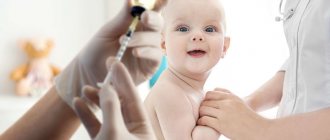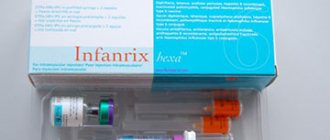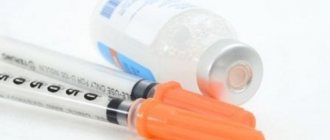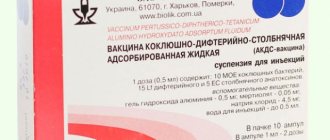Why BCG became inflamed - an overview of possible reactions
Vaccination against tuberculosis is mandatory in most countries; in Russia it is given to every newborn. For vaccination, the BCG vaccine is used, which contains the Calmette-Guerin bacillus.
It is a living causative agent of bovine tuberculosis, however, it is in a neutralized state.
As a rule, the BCG vaccine becomes inflamed after a certain time in each person, and the symptoms are usually not severe.
Main adverse reactions of tuberculosis vaccines
After the administration of the BCG vaccine, a small compaction forms at the injection site, followed by an inflammatory process that will persist for 30 to 90 days.
This condition should not cause any discomfort to the child.
Basically, the reaction to the injection occurs in the form of redness, swelling and thickening of the area of the body where the vaccination was performed. In some cases, other symptoms may be observed: pain in the legs, limping when moving.
The main complications after BCG are associated with incorrect administration of the drug due to failure to comply with the necessary conditions, which include:
- Vaccination must be carried out in a separate room.
- BCG vaccination is carried out using a special syringe intended for intradermal administration.
- the medical worker who will administer the vaccination must be qualified, since BCG has a complex administration technique, especially in newborns.
Vaccination against tuberculosis should not cause any specific reactions in the child such as elevated body temperature or enlarged lymph nodes.
Redness and inflammation of the skin
Redness after a BCG vaccination is considered a normal reaction, even for a whole year.
This can happen in different ways depending on the individual characteristics of each person.
So for some, the redness goes away after a week, while for others it lasts for more than 2 months. If such a reaction is detected, there is no need to visit a doctor, but when examined by a pediatrician, it should be noted that the vaccine has turned red.
After the BCG vaccination, a small swelling will appear at the injection site and a similar reaction will be observed for 2-3 days; it usually goes away on its own. This process should not cause concern.
After a month and a half, the process of suppuration and the formation of red pimples at the site of vaccination will begin, which is the final stage in the formation of a scar.
A keloid scar in the form of red and swollen skin at the site of vaccination indicates that the vaccine can no longer be administered to this patient.
Lump with pus at the injection site
The occurrence of an abscess at the injection site is especially fearful for most parents. Against this background, panic develops and for several months, when the process of suppuration begins, basically no one knows what needs to be done.
At the puncture site, a small abscess with a white head will form, covered in the middle with a crust, which is contraindicated to pick off and treat with ointments; it should go away on its own. The process of suppuration of the BCG vaccination is a normal condition and does not indicate any disorders in the child’s body.
In children suffering from immunodeficiency, severe purulent inflammation in the area of vaccination is possible. Such a reaction requires observation by a surgeon using conservative treatment, and in more severe circumstances it will be necessary to excise the affected tissue.
Increased body temperature
Detection of an elevated body temperature of up to 37.5 degrees in the evening on the day of BCG vaccination is considered a normal condition and does not require any action to be taken in this case.
If the temperature rises to 38-38.5 degrees, it is necessary to give the child an antipyretic drug before bedtime. If you notice a fever in the morning, you will need to call a doctor for an examination.
A similar reaction is observed in the case of insufficiently strengthened immunity. In such a situation, there is no need to worry, because although the child’s immunity is weak and cannot overcome the virus, he will not get tuberculosis. For the same reason, cough, runny nose and redness of the throat may develop.
Swollen lymph node
If the lymph node has increased by more than 1 centimeter, this may indicate that mycobacteria have entered it, which will require immediate consultation with a specialist and medical intervention to avoid complications.
Lymphadenitis is an inflammatory process of the lymph nodes accompanied by enlarged glands, in some cases it occurs with suppuration and the formation of a fistula or other signs of intoxication of the body.
Why does the BCG vaccination turn red in an adult or newborn child?
The BCG vaccine contains the bacteria of the tuberculosis virus in a weakened form, but despite this the body exhibits different reactions to them. There is no reason to worry if the vaccine turns red, as this is the norm. A similar reaction can be observed 6-8 weeks after vaccination.
Normally, the body should exhibit the following reactions to the tuberculosis vaccine:
- Increased body temperature no more than 37 degrees.
- The presence of mild inflammation at the injection site.
- A small suppuration in the center, which over time becomes covered with a crust.
- Induration and redness at the injection site up to 10 millimeters.
These symptoms are considered normal, but the list of the following reactions is a reason to visit a pediatrician or contact a phthisiatrician:
- The area of reddened skin around the injection is more than 1 centimeter.
- Various allergic reactions.
- High body temperature.
- The suppuration does not heal.
The presence of such complications can be caused by various factors: poor-quality vaccine, incorrect injection technique, etc.
How to care for a red scar after an injection for adults
To prevent unwanted side effects, the following recommendations must be followed after vaccination:
- The injection site should not be treated with ointment, cream or other anti-inflammatory drugs. The use of antiseptics is also contraindicated.
- A small abscess should not be squeezed out, as it is normal after BCG vaccination and will go away naturally. In its place, a scab forms, which also heals on its own and eventually falls off. It is not recommended to expose her to any physical contact.
- Swimming after vaccination is not prohibited, however, care must be taken to ensure that the skin is not injured.
What to do if a baby’s BCG vaccine becomes inflamed after a month
Inflammation of the vaccine can occur in an infant a month later, when a previously undisturbed festering wound breaks through. This is considered the norm, and it is after 1-2 months that it makes itself felt.
The vaccination site may become swollen and red.
There is nothing to worry about if the condition is not accompanied by a strong increase in temperature and other severe symptoms, as well as an increase in the diameter of the area around the injection by more than 1 centimeter.
If the injection site is swollen, will there be a scar on the shoulder?
After the pus has completely come out of the wound, it is necessary to cover it with gauze and change the bandage from time to time. Because of the abscess, a scar forms at the site of the vaccination.
The process begins with the abscess covering with a scab, after which the inflammation ends and a red pimple appears at the injection site. Over time, its walls become denser, and it itself settles.
This process continues until the skin heals.
In some cases, there may be no reaction to BCG even after several months. To determine the cause, it is necessary to perform a Mantoux test.
Lack of response may be due to the following reasons:
- The BCG vaccine was administered incorrectly or its composition was damaged. If the Mantoux test results are negative, revaccination is necessary.
- The scar has formed under the skin and is difficult to see. In this case, you need to consult a doctor who will identify it by the skin tone at the site of vaccine administration.
- If the ruble has disappeared, this indicates that the vaccine has stopped working.
Minor inflammation after the BCG vaccine is considered a normal and natural reaction of the body. There is no need to panic even if pus is detected.
However, in some cases, atypical reactions to vaccination are possible, which in the vast majority develop due to improper administration of the vaccine.
If severe symptoms or inflammation of other areas of the skin other than the injection site are detected, you should immediately consult a doctor to avoid further complications.
Source: https://vactsina.com/vse-vaktsinyi/btszh-vospalilas.html
Why does the BCG vaccination turn red in an adult or newborn child?
The BCG vaccine contains the bacteria of the tuberculosis virus in a weakened form, but despite this the body exhibits different reactions to them. There is no reason to worry if the vaccine turns red, as this is the norm. A similar reaction can be observed 6-8 weeks after vaccination.
Normally, the body should exhibit the following reactions to the tuberculosis vaccine:
- Increased body temperature no more than 37 degrees.
- The presence of mild inflammation at the injection site.
- A small suppuration in the center, which over time becomes covered with a crust.
- Induration and redness at the injection site up to 10 millimeters.
These symptoms are considered normal, but the list of the following reactions is a reason to visit a pediatrician or contact a phthisiatrician:
- The area of reddened skin around the injection is more than 1 centimeter.
- Various allergic reactions.
- High body temperature.
- The suppuration does not heal.
The presence of such complications can be caused by various factors: poor-quality vaccine, incorrect injection technique, etc.
BCG vaccination turned red: normal or pathological?
Already in the first days after birth in the maternity hospital, the baby is given vaccinations, one of them is BCG. The purpose of vaccination is to protect the body from developing serious complications of tuberculosis if infection occurs.
Moms are interested in the question of how long it takes for the injection site to heal, what the consequences and reactions of the body may be, is it normal if the BCG vaccine turns red? Truthful information on this topic will reassure parents and prepare them for possible situations.
Normal or not?
Each body reacts differently to vaccination, and the healing process depends on the individual. But doctors have signs by which they judge whether the vaccination went well.
Immediately after the injection, a papule appears on the site; its size should be no more than 1 centimeter. But after a few minutes everything resolves and the injection site is no different from neighboring skin areas.
After the BCG vaccination, redness and thickening are all within normal limits. Sometimes this condition is accompanied by slight itching. Most often, only a trace of the injection can be observed. Body temperature, as a rule, remains within normal limits at this time, but in some children it may rise slightly.
If the BCG vaccination becomes inflamed, then this is also considered normal, provided that the inflammatory process only affects the vaccination site itself. If swelling and inflammation begins to spread further, then you need to consult a doctor and find out the cause of this reaction.
After a couple of days, you can see redness at the injection site with the formation of a small abscess. If after the BCG vaccination the bubble is small and the surrounding skin is without signs of inflammation or swelling, then everything is fine.
After getting the vaccine, it is important to ask the doctor about possible reactions and situations when you need to sound the alarm, then you won’t have to worry about every issue.
Actions for inflammation
As a rule, most children tolerate the vaccination normally, although the healing process of BCG takes quite a long time. Most often, it is mothers who begin to panic when they discover redness, swelling or an abscess at the site of vaccine administration. By their actions they can only harm the healing process.
strictly not recommended if the injection site becomes red and an abscess forms:
- Scratch the vaccination site if itching occurs. If a child makes such attempts, it is better to cover the area with a napkin.
- Use antiseptics to speed up the healing process. The drugs may have a negative effect on weakened pathogens and the immune response will not form.
- Squeeze out the purulent contents, the pus will come out gradually on its own, it is only important to maintain cleanliness so as not to cause an infection.
A temperature rise of 37.5 degrees is normal. If the readings are higher, you can give your baby an antipyretic drug.
If the situation gets out of control
Although quite rare, there are situations when everything gets out of control and does not proceed at all as the doctor said. Despite the fact that few serious complications from vaccination against tuberculosis have been observed in medical practice, they should not be discounted.
As a rule, the healing situation can change dramatically if a complication occurs. The most common among them are:
- Osteomyelitis. If the BCG vaccine turns red the next day, and the adjacent tissues begin to swell, then you need to sound the alarm. When such a complication develops, it is almost painless, the joints become less mobile at a slow pace, and the process gradually affects the baby’s arms and legs. If you do not seek help in a timely manner, this can lead to the child developing complete immobility.
- Healing will go wrong if the technique of administering the vaccine is broken. When it gets under the skin, a purulent abscess develops, which can only be removed surgically.
- If the child’s immune system does not adequately accept the vaccine, an inflammatory process may begin in the lymph nodes.
The listed situations require immediate medical attention, because they pose a danger not only to the health, but also to the life of the baby.
Vaccinations now help prevent many serious diseases. Despite the fact that most children tolerate vaccination normally, mothers should be aware of how the healing process should normally proceed and in what cases medical help will be needed.
Source: https://tuberkulez-info.ru/profilaktika/privivka/btszh/reaktsiya-b/privivka-btszh-pokrasnela.html
BCG vaccination turned red: wait or run to a TB doctor?
BCG is one of the most common anti-tuberculosis vaccines in the world, which every newborn is introduced to in the first days of life.
The need for such early vaccination is due to the high risk of a child contracting tuberculosis , a disease transmitted by airborne droplets and affecting the entire respiratory system and the body as a whole.
Often, after the BCG vaccine is introduced into the body, redness appears at the injection site , and young mothers, worried, begin to look for information about this on websites and online forums. Should I sound the alarm if my child experiences redness at the site of the BCG vaccination?
ontakte
Odnoklassniki
Many parents consider any body response to a vaccine to be abnormal. This opinion is incorrect, since vaccine reactions are an integral part of the vaccination process.
Normally, after the vaccine is administered, a papule no larger than 1 centimeter in size forms at the injection site. This means that the vaccination was successful and the papule will resolve on its own in half an hour.
Other body reactions may also occur:
- Redness . If the vaccination site turns red and a small abscess has formed in it, do not rush to worry, such a reaction is not considered a pathology. This means that the injection site heals, and the body carries out a natural fight against foreign bodies and develops immunity. Sometimes a dense scar forms at the site of vaccine administration, extending beyond the wound, and the skin turns red and swells slightly.
This reaction is also normal and indicates that the skin has reacted to the vaccine. In addition, the redness of the graft may continue for a whole year .
For some this happens within a few days, for some by the end of the month, and for others only after six months.
In this case, there is no need to panic and run to consult a doctor, but you need to report redness during a routine examination.
- Swelling . After receiving the vaccine, the injection site may swell slightly. This reaction does not last long - 2-3 days and, as a rule, goes away on its own. In this case, there is no reason to worry. After a month and a half, suppuration begins and a red pimple appears at the site of vaccination, ending with the formation of a scar.
Important! Redness, swelling and suppuration should not spread to the tissue surrounding the graft. If the reaction becomes extensive, you should show the cause of concern to a phthisiatrician, as the wound may become infected and require treatment.
- Abscess . Often, parents begin to worry if the BCG vaccine turns red and an abscess occurs. In the normal course of the reaction, after a few months an abscess appears at the injection site, which gradually forms a crust. If suppuration of the wound occurs several times, a diagnosis of BCGitis is made, and the doctor prescribes appropriate treatment.
Important! During the healing period, the grafting site is vulnerable to infection. You cannot leave the wound open, much less tear off the scab yourself. Over time, it will go away on its own, and the grafting site will heal.
- Itching . If the BCG vaccine itches, there is no need to sound the alarm. Itching in this case occurs due to healing and restoration of the skin. However, you cannot rub or comb it; it is best to put a gauze napkin or put on gloves on the child’s vaccination.
- Temperature . If after administration of the vaccine the temperature rises no higher than 38 degrees and lasts for 2-3 days , there is no cause for concern. This is a normal reaction of the body to the introduction of foreign bacteria.
If your child has a high fever for more than 3 days , seek medical help immediately.
- Enlarged lymph nodes . The permissible enlargement of lymph nodes after vaccine administration is 1 cm . This reaction indicates the response of the body’s immune system to the vaccine. If the lymph nodes have seriously increased in size, this is a reason to consult a doctor, since this may be a sign of microbacteria entering them, which requires prompt medical intervention to avoid complications.
You should not burn the vaccination site with alcohol-containing substances, smear it with healing creams or seal it before swimming. The healing process of the vaccination site does not require external interventions.
BCG turned red - a normal reaction of the body
The spread of redness and other reactions at the vaccination site to adjacent tissues, a prolonged and critical increase in body temperature, and severe enlargement of the lymph nodes are reasons to consult a doctor to rule out infection.
If, after the administration of the vaccine, redness, suppuration or swelling appears that does not spread to adjacent tissues , do not panic. This is a completely normal reaction of the body to the introduction of foreign bacteria, which will pass on its own.
Photo 1. Redness at the site of BCG vaccination does not spread to adjacent tissues - a sign of a normal reaction.
An increase in lymph nodes by no more than 1 centimeter in diameter , as well as a non-critical increase in body temperature for less than 3 days , is an acceptable reaction. The occurrence of a reaction is the result of the fact that the vaccination was successful and there is no need to be afraid of it.
Why didn’t there remain a scar and a red spot after the vaccination?
There are cases when parents go to the doctor because there is no reaction (red spot, pustule, scar) several months after vaccination. The Mantoux test will help identify the cause.
A reaction to a vaccine may not appear for 2 reasons:
- The vaccine was administered incorrectly or its composition was damaged. If the Mantoux test is negative, it means that an error was made when administering the vaccine and revaccination is necessary.
The second vaccination is given after 7 years , but during this time such children should have a Mantoux test at least twice a year to avoid tuberculosis.
- The body already has natural immunity against tuberculosis and does not need any other protection. About 2% of the world's population has strong immunity to tuberculosis and other diseases. The body of such people blocks infectious pathogens even before the formation of antibodies begins. Therefore, no redness or scar is formed after vaccination.
There are cases when a scar forms under the skin of a child.
It is not visible visually, and may not be noticed during examination, but a good doctor will easily identify a subcutaneous scar, as a rule, by a change in the shade of the skin at the injection site (pinkish or reddish tint).
Such a reaction indicates that changes are occurring locally in the skin tissues. If the scar that appeared after vaccination has disappeared, this means that the vaccine has stopped working.
Reference! The absence of vaccination reactions to BCG occurs on average in 8% of children .
Recommendations for preparing a child for vaccination
- Stick to your usual diet. A few days before vaccination, refrain from introducing new foods into your baby’s diet. If the child is breastfed, it is better for the mother to avoid new foods in order to avoid the development of allergic reactions associated with the effects of the vaccine.
- Take antihistamines. Taking antihistamine drugs such as Suprastin is appropriate if the child has previously had allergic reactions. But only a doctor should prescribe the drug and dosage.
- Walk outdoors more often. The benefits of walking in nature before vaccination can hardly be overestimated. Fresh air has a beneficial effect on all vital processes of the body and stimulates the functioning of internal organs, which helps in the development of immunity, the fight against foreign bacteria and the successful vaccination process.
Photo 2.
A scar formed under the baby's skin means that changes are occurring in the tissue.
The child’s body is much better adapted to being in the fresh air than to a home environment where air exchange is disrupted due to the abundance of dust particles and chemical elements. So feel free to go for a walk and your child’s body will say “Thank you!”
About the benefits and harms of BCG vaccination, which often gives false positive diagnoses.
Rate this article:
Average rating: 5 out of 5. Rated by: 1 reader.
Share with your friends!
ontakte
Odnoklassniki
Source: https://no-tuberculosis.ru/vaktsinatsiya/bcg/reaktsiya/pokrasnela/
What to do if you have a fever
Heat
In rare cases, after the vaccine is administered, the skin at the injection site may swell slightly. There is also an increase in temperature to 38 degrees. But such a reaction is observed in rare cases.
Also, an increase in body temperature is observed during the formation of an abscess. In this case, it is the result of the formation of pus. This reaction is not considered a deviation from the norm.
The reason to consult a doctor is a rapid increase in body temperature immediately after administration of the drug, especially if the child is under 7 years of age.
Inflammation from the BCG vaccine is also normal. In appearance it resembles a small purulent formation. The surrounding tissue is not inflamed. This condition is considered a normal reaction of the body to the administered drug. But in cases where the inflammation has crossed the boundaries of the vaccination, swelling and severe itching appear, you need to consult a doctor. Trying to stop the symptom on your own may be unsafe for a newborn baby, especially after vaccination.
Children usually tolerate BCG well. But in certain cases, some symptoms may occur. Many of them should not cause concern to parents. But if your temperature rises, especially if it does not subside within 3-4 days, you should consult a doctor. Medicines can help reduce it, but do not stop the inflammatory process, which is the cause of the increase in temperature.
Is redness of the BCG vaccination site a cause for concern?
This situation often occurs: a child has been vaccinated against tuberculosis, and the area where the BCG vaccine was administered turns red.
This scares parents and questions arise: “What should I do? Is this normal? Some mothers and fathers, having heard a lot of other people’s stories, are wondering whether to give their baby this vaccination at all or not. But we are talking about the child’s health; tuberculosis is a rather dangerous disease that is easy to catch.
Penetrating into a weak body, it develops quickly and is difficult to treat. The material describes what to do if a child’s BCG vaccination turns red, and in what cases a doctor’s help is needed.
Redness of BLC - is it normal or a complication?
If a papule with a diameter of no more than 1 cm forms in the vaccination area, this is considered normal. This means that the immunization was successful, the lump will resolve on its own after 30 minutes. Other reactions to BCG may also occur.
- Redness. If the area turns red or a small abscess appears on it, do not worry. This phenomenon is not a pathology. It indicates that the vaccine injection site is healing, the body is fighting, and immunity is increasing.
- Sometimes a dense scar appears, the skin becomes red and slightly swollen. This is also a variant of the norm, this is how the skin reacts to the administration of the drug.
- After the BCG vaccination, thickening and redness appeared. Also a natural reaction.
- Edema. If the BLC is a little red and swollen, this phenomenon usually lasts 2-3 days and goes away on its own.
If BCG becomes inflamed and red, there is no need to panic. This is a sign of a normal reaction, the body’s natural response to the vaccine. In some cases there is no cause for concern:
- if the redness does not spread to adjacent areas of the skin;
- an increase in the diameter of the lymph nodes by no more than 1 cm;
- slight increase in body temperature lasting up to 3 days.
Why can BCG become inflamed immediately or after some time?
If the BCG vaccine makes your child very red, this is a consequence of one or more factors:
- non-compliance with the rules of drug administration;
- exceeding the vaccine limit;
- use of poor quality composition;
- individual perception of the body;
- BCG vaccination may turn red if there are contraindications to vaccination.
If the BCG vaccine in a newborn is a little inflamed and red, it’s not a big deal. It is difficult to predict how the baby’s body will react to a particular medication. For one, everything may go unnoticed, for another, inflammation will begin. This is the body's normal response and leaves a scar.
If the injection site is swollen, will there be a scar on the shoulder?
After the pus has completely come out of the wound, it is necessary to cover it with gauze and change the bandage from time to time. Because of the abscess, a scar forms at the site of the vaccination. The process begins with the abscess covering with a scab, after which the inflammation ends and a red pimple appears at the injection site. Over time, its walls become denser, and it itself settles. This process continues until the skin heals.
In some cases, there may be no reaction to BCG even after several months. To determine the cause, it is necessary to perform a Mantoux test.
Lack of response may be due to the following reasons:
- The BCG vaccine was administered incorrectly or its composition was damaged. If the Mantoux test results are negative, revaccination is necessary.
- The scar has formed under the skin and is difficult to see. In this case, you need to consult a doctor who will identify it by the skin tone at the site of vaccine administration.
- If the ruble has disappeared, this indicates that the vaccine has stopped working.
Minor inflammation after the BCG vaccine is considered a normal and natural reaction of the body. There is no need to panic even if pus is detected. However, in some cases, atypical reactions to vaccination are possible, which in the vast majority develop due to improper administration of the vaccine. If severe symptoms or inflammation of other areas of the skin other than the injection site are detected, you should immediately consult a doctor to avoid further complications.











